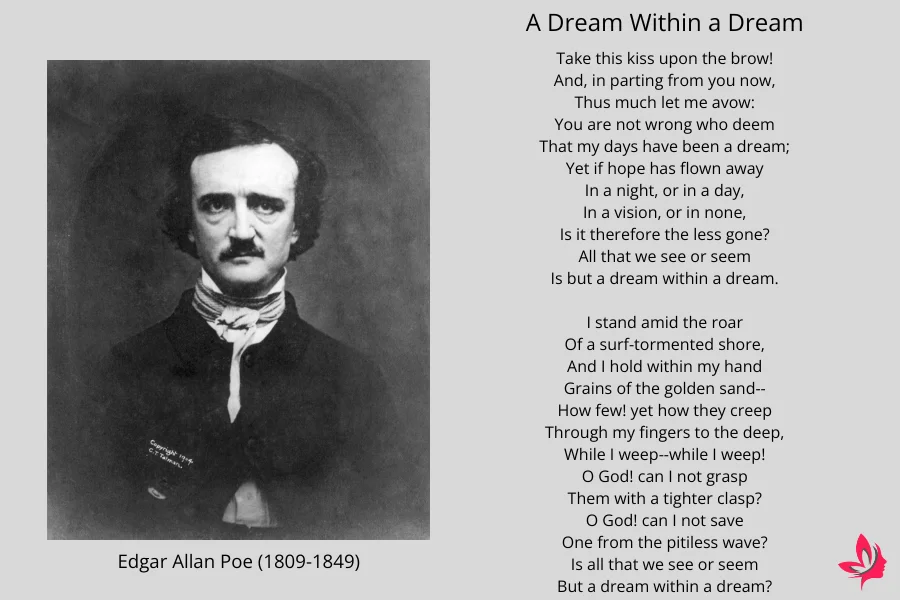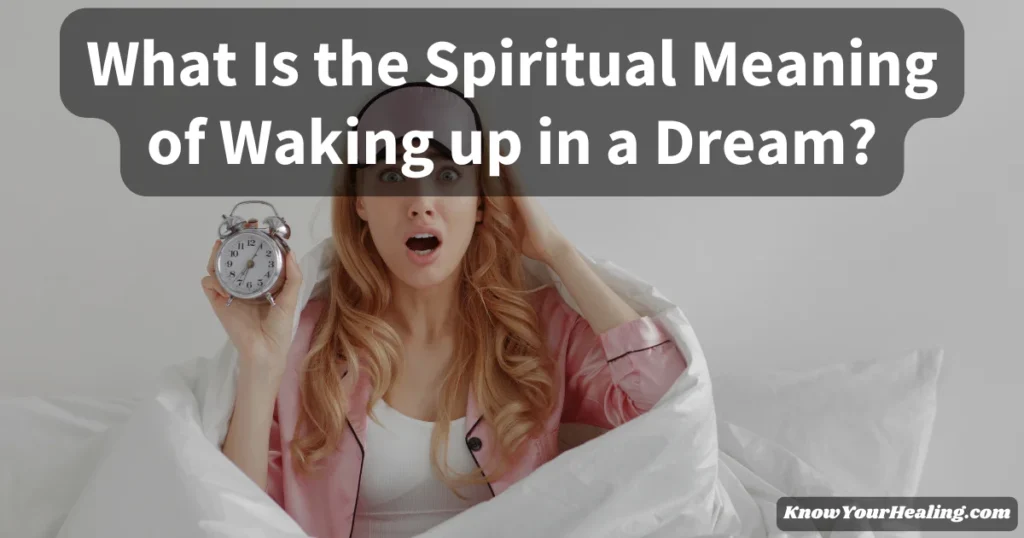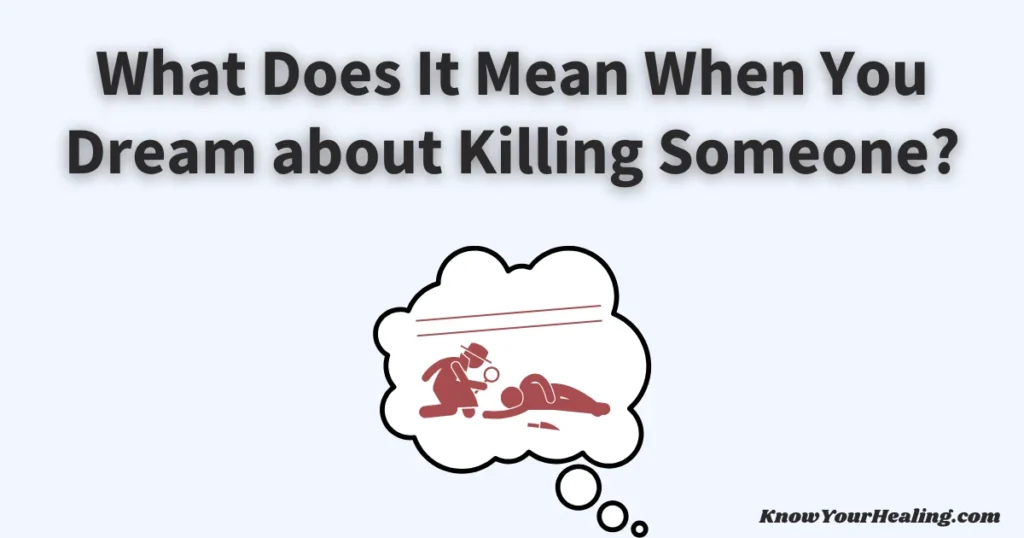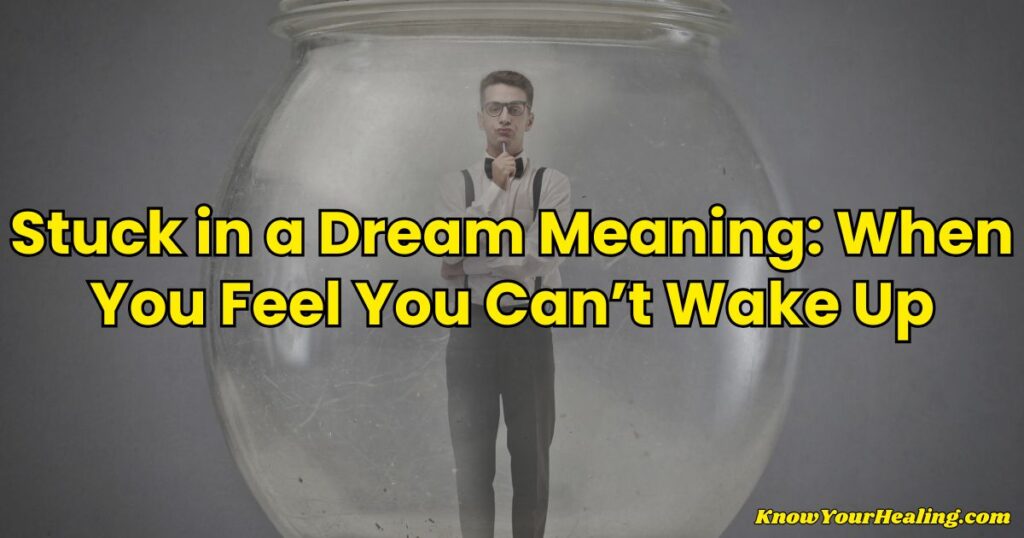Dream within a dream meaning can be confusing, leaving many people wondering what Edgar Allan Poe truly wanted to say in his famous poem.
This poem explores whether our lives, memories, and experiences are real or if they are just fleeting illusions—dreams within dreams.
For anyone looking to understand Poe’s reflections on reality and illusion, this article reveals the deeper message and themes behind his haunting words.
Many readers find themselves questioning their sense of reality after reading this poem.
Poe’s lines about time slipping away and our inability to hold onto life’s moments have captivated people for generations.
Understanding Edgar Allan Poe’s Dream Within a Dream Meaning

The dream within a dream meaning delves into the layers of reality and illusion that exist within both the waking and dreaming states.
Edgar Allan Poe employs vivid symbolism and poetic techniques to explore what can be genuinely held onto in life and dreams.
He often hints at the elusiveness of certainty and memory.
Exploring the First Stanza: Symbolism of the Surf-Tormented Shore and Pitiless Wave
In the first stanza, Poe sets the tone with the image of the “surf-tormented shore” and the “pitiless wave.”
These details evoke a relentless and indifferent natural world.
The shore represents the edge of reality, while the pitiless wave suggests how life, dreams, and moments are constantly being pulled away beyond our reach.
Poe’s choice of the word “tormented” adds a sense of struggle and suffering, suggesting that the border between the real world and the dream world is full of turmoil and uncertainty.
The “golden sand” slipping through the narrator’s fingers reflects the fleeting nature of time and personal experiences that can never be fully grasped, even in a lucid dream.
This symbolism raises questions about the permanence of experiences and memories, pointing to feelings of loss and helplessness that Poe faced.
Themes of existential uncertainty and the limits of human control echo throughout the poem.
The Role of Rhetorical Questions in Conveying Poe’s Dream Within a Dream Meaning
Poe relies heavily on rhetorical questions to express his uncertainty about reality and the nature of existence.
One of the most powerful rhetorical questions appears in the second stanza as the speaker wonders whether all we see and seem is “a dream within a dream.”
These questions do not ask for answers but invite readers to reflect on their own experiences with dreams, reality, and memory.
The questions echo the poem’s main theme: the confusion between the real world and the dream world.
This confusion is a common idea in psychology, especially in discussions surrounding false awakenings and lucid dreaming.
By using rhetorical questions, Poe sparks thought without providing closure, emphasizing the ongoing struggle to know what is real.
How the Tighter Clasp Represents the Elusiveness of Reality and the Dream World
When Poe writes of holding the golden sand with a “tighter clasp,” he illustrates the natural human urge to grip onto fleeting things.
Despite these efforts, the sand slips away, showing how moments, memories, and reality are difficult to hold onto, just like dreams after waking.
This image is tied to a sense of loss and the limits of human agency.
No matter how much the speaker wants to prevent time and experiences from disappearing, the tighter the clasp, the loss cannot be stopped.
The phrase also connects to the concept of retrieval cues—triggers that help us recall real experiences or memories.
Yet, as in the poem, even these recall attempts can fail, making the boundary between dream and real life even more uncertain.
Nested Dream and False Awakening: Layers of Conscious Awareness in Poe’s Poem
Poe’s poem hints at layers of conscious awareness, similar to nested dreams and false awakenings often reported in sleep studies.
A nested dream, sometimes referred to as a dream within a dream, occurs when a person realizes they are dreaming, only to wake up in another dream, further blurring the distinction between the waking state and the dreaming state.
Researchers have linked such experiences to changes in the brain during rapid eye movement (REM) sleep, a time when dreams are most vivid.
These states are also linked to sleep spindles and changes in the dorsolateral prefrontal cortex, which plays a role in distinguishing reality from dreams.
Through this lens, Poe’s poem explores the fragile boundary separating the real world from dreams, echoing research shared in the Journal of Clinical Sleep Medicine.
Comparing Poe’s Dream Within a Dream Meaning to Other Famous Poems and Literary Works
Many famous poems and stories deal with the boundaries between dreams and waking life.
For example, Lewis Carroll’s dream sequences in “Alice’s Adventures in Wonderland” also explore questions about reality, dreams, and personal identity.
Both Poe and Carroll challenge the reader to question which state, if any, can be trusted as “real.”
Compared to other literary works, Poe’s focus on rhetorical questions and existential despair makes “A Dream Within a Dream” a unique piece.
While some works use dream logic to resolve conflicts, Poe’s poem offers no simple answers and instead asks readers to accept uncertainty.
This is similar to philosophical debates about reality that appear in texts from various eras.
The Science Behind Dreams and Their Connection to Poe’s Dream Within a Dream Meaning

Edgar Allan Poe’s “A Dream Within a Dream” raises questions about the nature of reality, the limits of human understanding, and the psychological meaning behind fleeting experiences.
Modern science reveals that these themes align closely with how the brain processes dreams, consciousness, and personal experience.
Brain States and Dream Sequences: From Rapid Eye Movement to Sleep Spindles
Dreaming often occurs in specific brain states, such as rapid eye movement (REM) sleep and periods marked by sleep spindles.
REM is when vivid dream sequences happen, and the brain’s activity is high, much like being awake but without complete conscious control.
Sleep spindles, short bursts of brain activity, help process memories and blend the “real world” with dream experiences.
Just as Poe describes the loss of “golden sand” slipping through his fingers, science shows that memories can become distorted or lost during these sleep stages.
This biological process may explain why dreams feel so ephemeral, much like the transient moments described in the poem’s second stanza.
| Brain State | Key Feature | Relevance to Poe |
|---|---|---|
| REM Sleep | Vivid Dreams | Dream World, Illusion |
| Sleep Spindles | Memory Integration | Fading Memories |
Lucid Dreaming, False Awakening, and Sleep Paralysis: Insights from the Journal of Clinical Sleep Medicine
Some dreamers experience lucid dreams, where they gain conscious awareness within the dream world and can even control events.
Others report false awakening, where they believe they’ve woken up, but are still dreaming.
These phenomena, documented in the Journal of Clinical Sleep Medicine, parallel Poe’s nested dream or “dream within a dream” theme.
Sleep paralysis, another common occurrence, happens when the body is temporarily unable to move upon waking or falling asleep.
This strange experience blurs the line between the awake state and the dream state, offering a glimpse into Poe’s rhetorical questions about reality and illusion in his famous poem.
How the Dorsolateral Prefrontal Cortex Influences Conscious Awareness in the Dreaming State
The dorsolateral prefrontal cortex plays a crucial role in conscious thought, decision-making, and self-awareness during wakefulness.
During REM sleep, this area becomes less active, which is why dreams can feel illogical or out of control.
When this brain area is more active, as in lucid dreaming, people can realize they are dreaming and act with intention, almost as if trying to grasp “golden sand” with a tighter grasp.
Poe’s first stanza, with its questioning of what is real, echoes this blending of awareness and confusion seen between waking and dreaming.
Prophetic Dreams, Retrieval Cues, and the Role of Personal Experience in Dream Interpretation
Prophetic dreams are those that seem to predict the future. Still, most scientists believe these are the brain’s way of matching dream content to personal experiences or retrieval cues—triggers that prompt us to recall specific memories.
The meaning of a dream within a dream often depends on the individual’s personal life and current emotions.
Poe’s use of the “surf-tormented shore” and “pitiless wave” offers images open to interpretation, shaped by the reader’s own experiences.
Like all dreams, interpretation is a personal process that evokes memories and emotions through retrieval cues from both daily and dream life.
Understanding the Awake State Versus the Waking State: Bridging Real Life and the Dream World
The distinction between being truly awake and merely believing oneself to be awake—the waking state—has perplexed both scientists and writers.
The real world and dream world often overlap in memory, making people question what is genuinely real.
This confusion, experienced after a false awakening or a vivid dream, connects to Poe’s famous rhetorical questions in both stanzas and the feeling of living inside a nested dream.
For some, contemplating these boundaries serves as a poignant reminder that human perception can be fragile and fleeting.
Concepts from works by Edgar Allan Poe and authors like Lewis Carroll continue to serve as cultural bridges between scientific findings and more profound questions about the nature of existence.
Applying the Dream Within a Dream Meaning to Personal Life and Healing

The dream within a dream meaning helps people better understand how fragile and shifting reality can feel in personal experience.
By examining how Edgar Allan Poe explores the concepts of illusion, time, and identity, you can reconsider your approach to managing stress, cultivating self-awareness, and navigating life’s changes.
Using Poe’s Dream Within a Dream Meaning as a Good Reminder for Mindfulness and Conscious Awareness
Edgar Allan Poe’s “A Dream Within a Dream” explores the idea that what we see or seem in life may only be another layer of illusion.
The poem’s lines, such as “all that we see or seem is but a dream within a dream,” serve as a poignant reminder to question our day-to-day perceptions and remain conscious of each moment.
Practicing mindfulness encourages a tighter clasp on the present, even as it slips away.
Whether someone is waking or caught in a false awakening, being aware can help break cycles of stress or distraction.
This approach also aligns with recent research on brain states and sleep, indicating that moments of conscious awareness, even during rapid eye movement sleep or dreamy states, can enhance mental well-being.
List of practical steps:
- Pause and breathe during stressful moments
- Ask simple rhetorical questions to spark conscious thought
- Notice small details that make up the “dream world” of each day
In the second stanza, Poe’s speaker stands “amid the roar of a surf-tormented shore,” holding grains of golden sand that slip through his fingers.
The golden sand represents precious moments or memories that people try to hold onto but often lose due to distraction, anxiety, or the busyness of daily life.
Holding onto “a little bit of reality”—those moments that matter most—can help anyone through personal loss or stress.
The poem’s grief over lost time resonates with real-life struggles to preserve what is valuable.
Focusing on the present and using reminders, such as photos or journals, helps people stay grounded in reality instead of regretting what is lost.
Table:
| Symbol | Personal Meaning |
|---|---|
| Golden Sand | Precious memories/time |
| Surf-Tormented Shore | Life’s daily struggles |
How Astrological Sign and Dream Patterns Influence Dream Interpretation and Healing
Astrological signs and individual dream patterns can change how people connect with Poe’s poem.
Some people experience lucid dreams, prophetic dreams, or even sleep paralysis, which can blur the line between dreaming and being awake.
The poem’s layers of dreams and “reality” reflect these real brain states.
Research in the Journal of Clinical Sleep Medicine indicates that personality and sleep habits, such as the amount of rapid eye movement, influence dream recall and meaning.
Someone who tracks their dreams in a journal or pays attention to their sleep patterns might relate differently to Poe’s theme of slipping reality, using it for personal healing and growth.
Lessons from Lewis Carroll and the Flag of Our Union: Dream Within a Dream Meaning in Cultural Context
Edgar Allan Poe was not the only famous writer to use dream sequences.
Lewis Carroll’s works, especially “Through the Looking-Glass,” explore dream worlds and the shifting nature of reality.
Both authors raise questions about what is real and what is imagined, revealing a shared cultural interest in uncovering more profound truths.
The flag of our union, which represents unity and identity, stands as a metaphor for how cultural symbols shape both waking and dreaming life.
Dreams, literature, and history all blend to shape how people see themselves and their place in the world.
These references help people navigate rapid change or confusion between the real world and the dream world.
Embracing a Good Heart and the Second Dream: Moving Beyond Retention Error in Real World Challenges
The poem’s “second dream” encourages hope and new beginnings, even in the face of the “pitiless wave.”
Readers can use this message to address real-world retention errors, which include the loss of memories, goals, or good intentions.
Maintaining a good heart means remaining compassionate toward oneself and others, even when life feels confusing or challenging.
Whether facing personal setbacks or moments of false awakening, focusing on kindness and learning from each “second dream” can bring healing and a renewed sense of purpose.
Self-reflection and support from others help people make sense of shifting realities and move forward with greater understanding.
Frequently Asked Questions
Edgar Allan Poe’s poem explores how life can feel unreal, like illusions inside of other illusions.
The poem explores the themes of losing control, the passage of time, and how experiences can slip through one’s grasp.
What does it mean if you have a dream inside of a dream?
Having a dream inside a dream often makes people question what is real and what is not.
In literature and real life, it can show confusion, stress, or a sense that reality is fragile.
Poe uses this idea to highlight feelings of uncertainty and loss of control over life’s events.
What is the central message of A Dream Within a Dream?
The main message is that life can seem like an illusion, and events may not be as real or lasting as they appear.
Poe suggests that what people experience might be as fleeting as a dream, adding depth to the meaning of “A Dream Within a Dream”.
What is it called when you have a dream in a dream in a dream?
This is called a nested dream or a recursive dream.
It refers to experiencing multiple layers of dreaming, where a person dreams, wakes up in another dream, and repeats the cycle.
What causes A Dream Within a Dream?
Such dreams can be caused by stress, anxiety, or deep thoughts that occur just before sleep.
In Poe’s poem, this idea symbolizes a sense of helplessness regarding the passage of time and the struggle to grasp reality.
What is the spiritual meaning of having a dream in a dream?
Spiritually, dreaming within a dream is sometimes seen as a sign of awakening or transformation.
This can suggest that life itself may be an illusion or a journey through various levels of awareness.
What is the symbol of a dream within a dream?
In the poem, sand slipping through the speaker’s fingers is a symbol of time, loss, and the inability to control or hold onto moments.
More broadly, a dream within a dream often symbolizes fragile reality and how difficult it is to distinguish what is true from what is only imagined.
What does it mean when you wake up from a dream inside a dream?
Waking up from a dream inside another dream can leave a person feeling confused or unsure if they are awake.
In some cases, it highlights fears of being trapped or not being able to trust one’s senses.
Can you get stuck in a dream within a dream?
Getting stuck in a series of dreams is very rare, but some people do report it.
Typically, a person can eventually wake up feeling normal, although they may still remember the experience as unsettling or strange.
When you wake up from a dream within a dream?
People often experience a mix of relief and confusion when they wake up from this type of dream.
The sensation can blur the boundary between dream and reality for a short time.
What happens if you dream that you are dreaming?
If you dream that you are dreaming, your mind might be reflecting on deeper worries or thoughts. This layered experience can make you question what is real and what is not.




